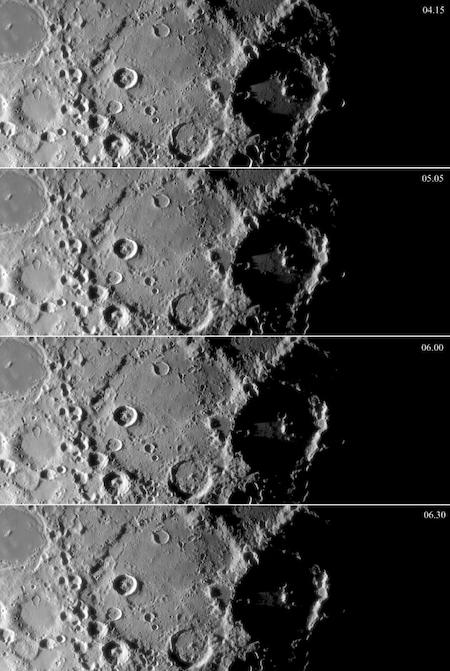
Date: May 9, 2003 Time: 20:30 - 21:30 UT+3 Location: 38.2997-deg N, 23.7430-deg E Conditions: Clear skies and excellent seeing Instrument: Celestron 14" SCT, Losmandy G11 mount, ScopeTronix 14 SWA
With the sun approaching the horizon I decided to start setting up the scope for some star-hopping later that evening. With the moon immediately overhead, I decided to turn the OTA against the moon to set the focus point and for a quick peek at the moon. I was impressed with the amount of contrast while slewing up and down the terminator of the seven-day old moon and in spite of the sun's presence in the west. Within seconds my eye caught a lunar ray just to the east of the terminator and which was immediately recognized to be Crater Walter.
I kept my eye glued to the eyepiece (279x) for a solid 60 minutes hoping to see some change in the arc-angle of the ray without any success. A very small craterlet near the gap in the crater wall and source of incoming light was used in my attempts to look for changes in the ray of light during the sixty minutes of observation. I would estimate the ray to have subtended an angle of approximately 100 degrees.
It is interesting to note that this ray is/was not predicted for this particular day and time and was a pleasant surprise. I took approximately 40 images of the light ray using a Nikon Coolpix 995 but was not impressed with the quality due to slight misfocus and I will attempt a repeat imaging session as soon as possible. I would have preferred to image using my SBIG CCD camera but did not want to invest the 10 minutes or so which would have been required to setup the gear as I was not sure for how long this ray was about to last and, of course, I gave priority to its observation and quick attempts at using the digicam.
I just checked my notes ... "subtended an angle of approximately 60 degrees. Also, a very small crater in the immediate vicinity exhibited a light ray as well and I will confirm both of these rays in tandem with a photo at the first opportunity possible."Anthony Ayiomamitis Athens, Greece
I observed for the first time this morning the sunset ray in Walter, discovered by our friend Dave Mitsky. A spreading wedge of light was cast across the floor by a gap in the wall, the small crater near the gap looking like a tiny crown and casting three pointed shadows a third of the way across the floor towards the central peak. The observation was made with my 28cm f/4.3 Starmaster Newtonian at 240x and 300x using a binoviewer, from my back yard in downtown Toronto. It was observed on 2002-08-30 between 08:30 and 10:15 UT...I kept going back to it all through the session, watching the shadow of the three peaks creep across the floor. As I watched, the Sun got lower, the floor darkened, and the shadow of the three peaks stretched ever closer to the central peak
Date: 2002/1/6 Time: 7:45 to 9:55 UT Location: ~10 kilometers east of Harrisburg, PA Conditions: temperature - 2 degrees Celsius, mostly clear then becoming hazy and partly cloudy, average seeing Instruments: 80mm f/5 achromatic refractor, 101mm f/5.4 Petzval fluorite refractor, 114mm f/7.9 equatorial Newtonian Much to my suprise the skies cleared on Sunday morning and I was able to observe the Walter Lunar Sunset Ray from about 7:45 UT (when it was a broad triangular shape) to its peak (i.e., when the ray was at its narrowest width) at 9:54 UT. Walter's central peak was illuminated quite nicely as the event transpired. The last thirty minutes or so the transparency deteriorated as clouds moved in from the west. (I knew the conditions were worsening when a 44 degree lunar halo appeared and the air became colder and more damp.) I viewed the event first through my 80mm f/5 Orion ShortTube 80 refractor using a 7mm Siebert wide-field eyepiece (57x) alone and in conjunction with a 2x Celestron Ultima Barlow lens. Later at approximately 8:30 UT I set up my 101mm f/5.4 Tele Vue Genesis sdf refractor and took some eyepiece projection shots using a 26mm Tele Vue Ploessl and a Pentax K-1000 SLR. To get a bit more image scale I readied my 114mm f/7.9 Celestron C4.5 Newtonian but the moon was beginning to be bathed in haze by then so I didn't do any further photography. Before the haze and clouds appeared I had good views of the event through the Genesis using an 8mm Tele Vue Radian (67x) and a 7mm Tele Vue Nagler (77x) alone and with the Ultima Barlow lens. (The seeing wasn't good enough to support the use of my 2.5x Tele Vue Powermate.) However, even when the haze was at its worst I could still see the pencil thin shaft of light. Dave Mitsky
A report that Dave Mitsky wrote for the ASH newsletter Stardust can be found at http://www.astrohbg.org/mitsky/walter_lunar_ray.htm (Note there are a few mistakes that the editor and webmaster made that need to be changed.)
Steve Rasmussen's image of the Walter Ray from 9/13/98, is located at http://www.avalon.net/~srass/walter.htm
Bill Arnett's images from 2:30 a.m. PDT 8/4/99 are at http://www.seds.org/billa/psc/walter/walter.html
Akkana's Shallow-Sky web site located at http://www.shallowsky.com/moon/rukl65.html
Oct 28, 2021:
Photo of Walther (Walter) crater. Photographer did not know of the ray event. He commented on the region, but not the ray. Three-hour photo session, October 28, 2021. Moon 18-15 hours before third quarter, at an altitude of about 60 degrees, in good conditions. Monochromator based on the TS Individual 152/900 achromatic refractor with a Baader Hα 35nm filter, Barlow Celestron Ultima 2x (F equiv. 2200mm), ASI290MM, EQ-ATM, FireCapture2.6, Autostakkert!3, ImPPG. Re-processed photos. Cloudy Nights - User Loxley, Częstochowa, Poland
